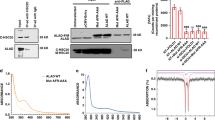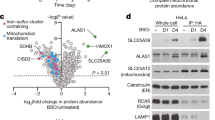Abstract
The movement of anionic porphyrins (for example, haem) across intracellular membranes is crucial to many biological processes, but their mitochondrial translocation and coordination with haem biosynthesis is not understood. Transport of porphyrins into isolated mitochondria is energy-dependent1,2,3, as expected for the movement of anions into a negatively charged environment. ATP-binding cassette transporters actively facilitate the transmembrane movement of substances. We found that the mitochondrial ATP-binding cassette transporter ABCB6 is upregulated (messenger RNA and protein in human and mouse cells) by elevation of cellular porphyrins and postulated that ABCB6 has a function in porphyrin transport. We also predicted that ABCB6 is functionally linked to haem biosynthesis, because its mRNA is found in both human bone marrow and CD71+ early erythroid cells (by database searching), and because our results show that ABCB6 is highly expressed in human fetal liver, and Abcb6 in mouse embryonic liver. Here we demonstrate that ABCB6 is uniquely located in the outer mitochondrial membrane and is required for mitochondrial porphyrin uptake. After ABCB6 is upregulated in response to increased intracellular porphyrin, mitochondrial porphyrin uptake activates de novo porphyrin biosynthesis. This process is blocked when the Abcb6 gene is silenced. Our results challenge previous assumptions about the intracellular movement of porphyrins and the factors controlling haem biosynthesis.
This is a preview of subscription content, access via your institution
Access options
Subscribe to this journal
Receive 51 print issues and online access
$199.00 per year
only $3.90 per issue
Buy this article
- Purchase on Springer Link
- Instant access to full article PDF
Prices may be subject to local taxes which are calculated during checkout




Similar content being viewed by others
References
Rebeiz, N., Arkins, S., Kelley, K. W. & Rebeiz, C. A. Enhancement of coproporphyrinogen III transport into isolated transformed leukocyte mitochondria by ATP. Arch. Biochem. Biophys. 333, 475–481 (1996)
Koller, M. E. Studies on the uptake of porphyrin by isolated rat liver mitochondria with particular emphasis on the effect of hemin. FEBS Lett. 100, 47–51 (1979)
Koller, M. E. & Romslo, I. Uptake of protoporphyrin IX by isolated rat liver mitochondria. Biochem. J. 188, 329–335 (1980)
Ponka, P. Cell biology of heme. Am. J. Med. Sci. 318, 241–256 (1999)
Tsiftsoglou, A. S., Nunez, M. T., Wong, W. & Robinson, S. H. Dissociation of iron transport and heme biosynthesis from commitment to terminal maturation of murine erythroleukemia cells. Proc. Natl Acad. Sci. USA 80, 7528–7532 (1983)
Sassa, S. & Kappas, A. Succinylacetone inhibits delta-aminolevulinate dehydratase and potentiates the drug and steroid induction of delta-aminolevulinate synthase in liver. Trans. Assoc. Am. Physicians 95, 42–52 (1982)
Jonker, J. W. et al. The breast cancer resistance protein protects against a major chlorophyll-derived dietary phototoxin and protoporphyria. Proc. Natl Acad. Sci. USA 99, 15649–15654 (2002)
Krishnamurthy, P. et al. The stem cell marker Bcrp/ABCG2 enhances hypoxic cell survival through interactions with heme. J. Biol. Chem. 279, 24218–24225 (2004)
Locher, K. P. Structure and mechanism of ABC transporters. Curr. Opin. Struct. Biol. 14, 426–431 (2004)
Graf, G. A., Cohen, J. C. & Hobbs, H. H. Missense mutations in ABCG5 and ABCG8 disrupt heterodimerization and trafficking. J. Biol. Chem. 279, 24881–24888 (2004)
Gardner, L. C. & Cox, T. M. Biosynthesis of heme in immature erythroid cells: the regulatory step for heme formation in the human erythron. J. Biol. Chem. 263, 6676–6682 (1988)
Mitsuhashi, N. et al. MTABC3, a novel mitochondrial ATP-binding cassette protein involved in iron homeostasis. J. Biol. Chem. 275, 17536–17540 (2000)
Furuya, K. N., Bradley, G., Sun, D., Schuetz, E. G. & Schuetz, J. D. Identification of a new P-glycoprotein-like ATP-binding cassette transporter gene that is overexpressed during hepatocarcinogenesis. Cancer Res. 57, 3708–3716 (1997)
Hirsch-Ernst, K. I. et al. Molecular cDNA cloning and tissue distribution of mRNA encoding a novel ATP-binding cassette (ABC) half-transporter. Biochem. Biophys. Res. Commun. 249, 151–155 (1998)
Ferreira, G. C., Andrew, T. L., Karr, S. W. & Dailey, H. A. Organization of the terminal two enzymes of the heme biosynthetic pathway. Orientation of protoporphyrinogen oxidase and evidence for a membrane complex. J. Biol. Chem. 263, 3835–3839 (1988)
Light, W. R. III & Olson, J. S. The effects of lipid composition on the rate and extent of heme binding to membranes. J. Biol. Chem. 265, 15632–15637 (1990)
Light, W. R. III & Olson, J. S. Transmembrane movement of heme. J. Biol. Chem. 265, 15623–15631 (1990)
Ricchelli, F., Gobbo, S., Jori, G., Salet, C. & Moreno, G. Temperature-induced changes in fluorescence properties as a probe of porphyrin microenvironment in lipid membranes. 2. The partition of hematoporphyrin and protoporphyrin in mitochondria. Eur. J. Biochem. 233, 165–170 (1995)
Lavi, A., Weiman, H., Holmes, R. T., Smith, K. M. & Ehrenberg, B. The depth of porphyrin in a membrane and the membrane's physical properties affect the photosensitizing efficiency. Biophys. J. 82, 2101–2110 (2002)
Kepczynski, M., Pandian, R. P., Smith, K. M. & Ehrenberg, B. Do liposome-binding constants of porphyrins correlate with their measured and predicted partitioning between octanol and water? Photochem. Photobiol. 76, 127–134 (2002)
Kuzelova, K. & Brault, D. Kinetic and equilibrium studies of porphyrin interactions with unilamellar lipidic vesicles. Biochemistry 33, 9447–9459 (1994)
Susa, S. et al. Heme inhibits the mitochondrial import of coproporphyrinogen oxidase. Blood 100, 4678–4679 (2002)
Aft, R. L. & Mueller, G. C. Hemin-mediated DNA strand scission. J. Biol. Chem. 258, 12069–12072 (1983)
Aft, R. L. & Mueller, G. C. Hemin-mediated oxidative degradation of proteins. J. Biol. Chem. 259, 301–305 (1984)
Kuross, S. A., Rank, B. H. & Hebbel, R. P. Excess heme in sickle erythrocyte inside-out membranes: possible role in thiol oxidation. Blood 71, 876–882 (1988)
Krieg, R. C. et al. Intracellular localization is a cofactor for the phototoxicity of protoporphyrin IX in the gastrointestinal tract: in vitro study. Photochem. Photobiol. 78, 393–399 (2003)
Piomelli, S., Brickman, A. & Carlos, E. Rapid diagnosis of iron deficiency by measurement of free erythrocyte porphyrins and hemoglobin: the FEP/hemoglobin ratio. Pediatrics 57, 136–141 (1976)
Sassa, S. & Kappas, A. Molecular aspects of the inherited porphyrias. J. Intern. Med. 247, 169–178 (2000)
Visvader, J. E., Mao, X., Fujiwara, Y., Hahm, K. & Orkin, S. H. The LIM-domain binding protein Ldb1 and its partner LMO2 act as negative regulators of erythroid differentiation. Proc. Natl Acad. Sci. USA 94, 13707–13712 (1997)
Acknowledgements
We thank S. Naron for editorial assistance; J. Groff for preparation of the illustrations; A. Smith for comments and suggestions; S. Orkin for providing the G1ER cells; B. Sarkadi and C. Ozvegy-Laczka for assistance with the ATPase assays; and Y. Fan for bioinformatics analysis of Abcb6. This work was supported by NIH grants and by the American Lebanese Syrian Associated Charities (ALSAC).
Author information
Authors and Affiliations
Corresponding author
Ethics declarations
Competing interests
Reprints and permissions information is available at www.nature.com/reprints. The authors declare no competing financial interests.
Supplementary information
Supplementary Notes
This file contains the Supplementary Methods, Supplementary Figure Legends and Supplementary Table. (DOC 53 kb)
Supplementary Figures
This file contains the Supplementary Figures 1–5. (PDF 733 kb)
Rights and permissions
About this article
Cite this article
Krishnamurthy, P., Du, G., Fukuda, Y. et al. Identification of a mammalian mitochondrial porphyrin transporter. Nature 443, 586–589 (2006). https://doi.org/10.1038/nature05125
Received:
Accepted:
Published:
Issue Date:
DOI: https://doi.org/10.1038/nature05125
This article is cited by
-
Nrf2 and Ferroptosis: A New Research Direction for Ischemic Stroke
Cellular and Molecular Neurobiology (2023)
-
Detection of superficial and buried optic disc drusen with swept-source optical coherence tomography
BMC Ophthalmology (2022)
-
Identification and characterization of a heme exporter from the MRP family in Drosophila melanogaster
BMC Biology (2022)
-
HIF-1-dependent heme synthesis promotes gemcitabine resistance in human non-small cell lung cancers via enhanced ABCB6 expression
Cellular and Molecular Life Sciences (2022)
-
Transcriptomic Response of Primary Human Bronchial Cells to Repeated Exposures of Cigarette and ENDS Preparations
Cell Biochemistry and Biophysics (2022)
Comments
By submitting a comment you agree to abide by our Terms and Community Guidelines. If you find something abusive or that does not comply with our terms or guidelines please flag it as inappropriate.



